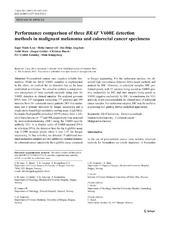Performance comparison of three BRAF V600E detection methods in malignant melanoma and colorectal cancer specimen
Løes, Inger Marie; Immervoll, Heike; Angelsen, Jon-Helge; Horn, Arild; Geisler, Jürgen; Busch, Christian; Lønning, Per Eystein; Knappskog, Stian
Peer reviewed, Journal article
Published version
Permanent lenke
https://hdl.handle.net/1956/10434Utgivelsesdato
2015-02Metadata
Vis full innførselSamlinger
Originalversjon
https://doi.org/10.1007/s13277-014-2711-5Sammendrag
Personalized cancer care requires reliable biomarkers. While the BRAF V600E mutation is implemented in the clinic, no method for its detection has so far been established as reference. We aimed to perform a comprehensive comparison of three methods currently being used for V600E detection in clinical samples. We analysed genomic DNA from 127 malignant melanomas (77 patients) and 389 tumours from 141 colorectal cancer patients (383 liver metastases and 6 primary tumours) by Sanger sequencing and a single probe-based high-resolution melting assay (LightMix). Formalin-fixed paraffin-embedded (FFPE) tissue from a subset of these lesions (n = 77 and 304, respectively) was analysed by immunohistochemistry (IHC) using the V600E-specific antibody VE1. In a dilution series of V600E-mutated DNA in wild-type DNA, the detection limit for the LightMix assay was 1:1000 mutated alleles while it was 1:10 for Sanger sequencing. In line with this, we detected 15 additional mutated melanoma samples and two additional mutated metastatic colorectal cancer samples by the LightMix assay compared to Sanger sequencing. For the melanoma samples, we observed high concordance between DNA-based methods and analysis by IHC. However, in colorectal samples, IHC performed poorly with 12 samples being scored as V600E positive exclusively by IHC and nine samples being scored as V600E negative exclusively by IHC. In conclusion, the VE1 antibody is not recommendable for clinical tests of colorectal cancer samples. For melanoma samples, IHC may be useful as a screening tool guiding further analytical approaches.

